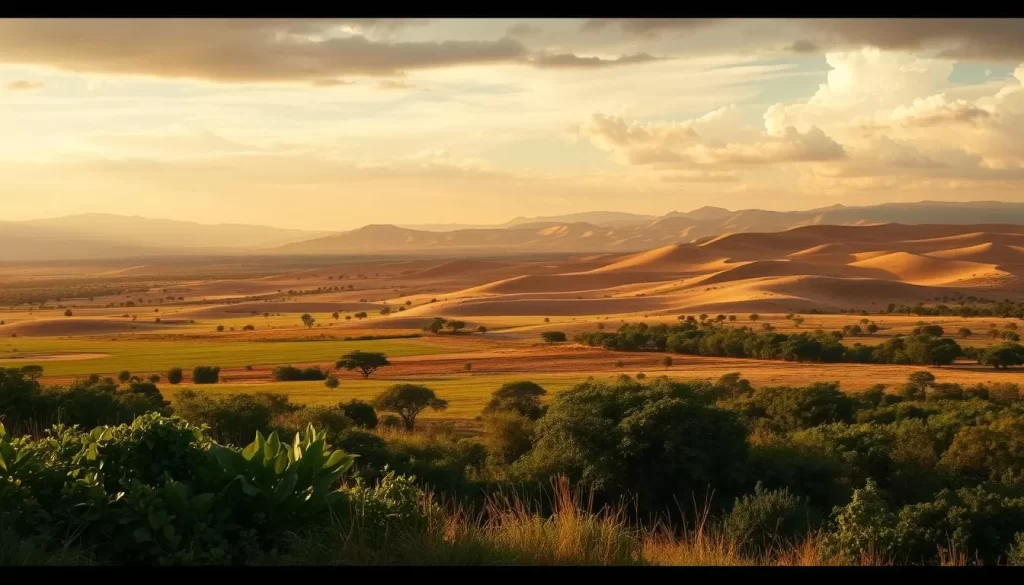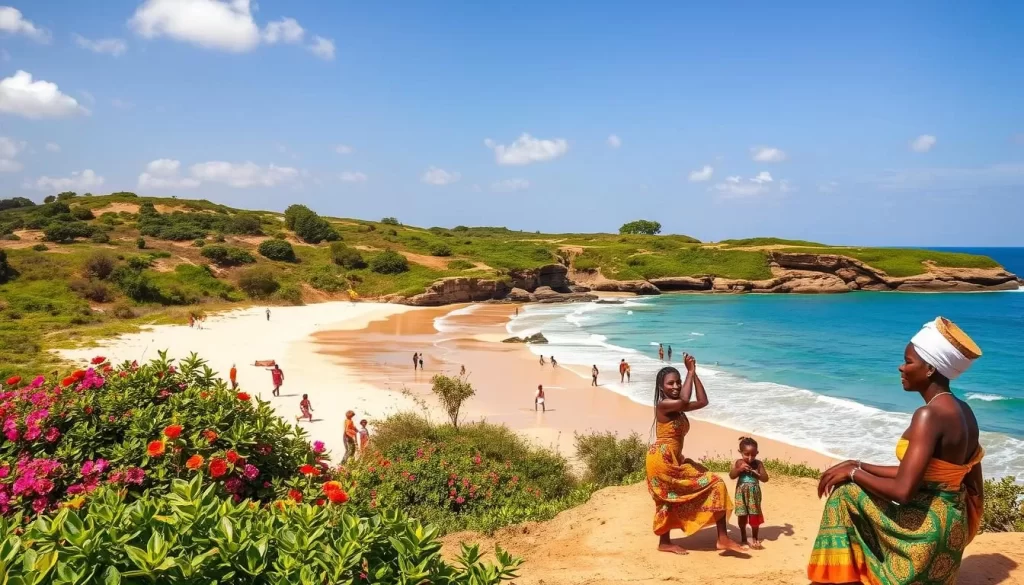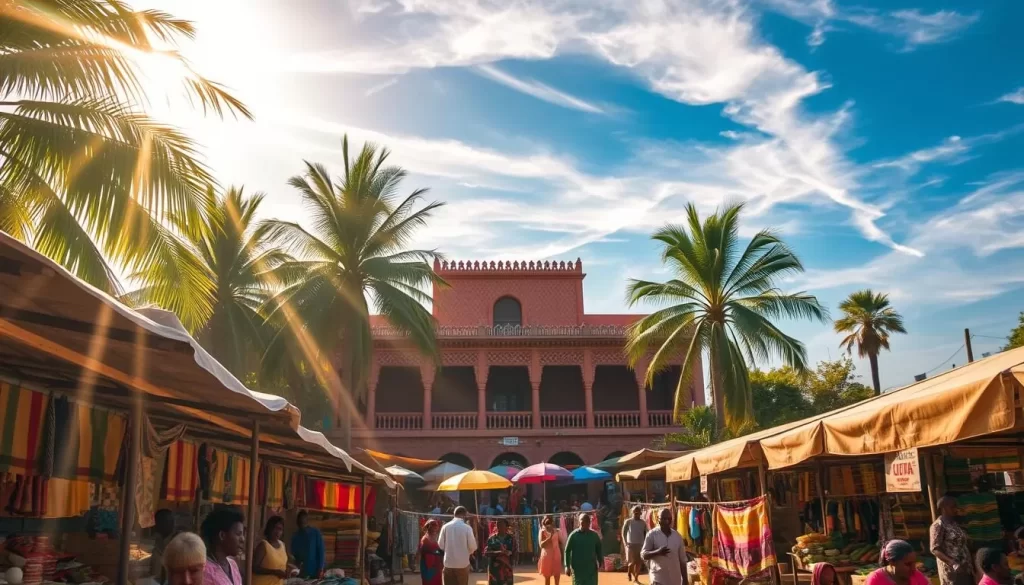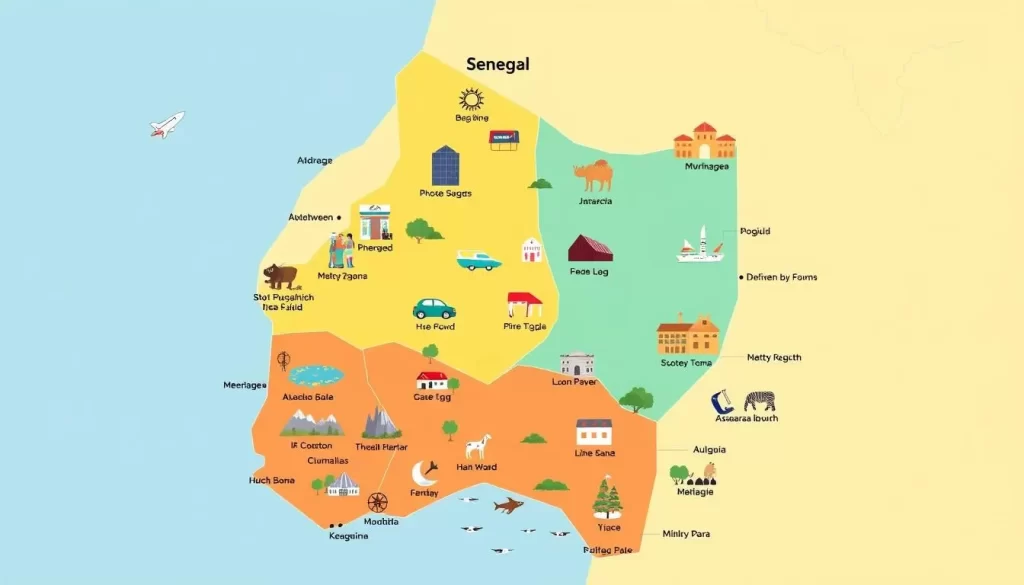You’re planning a trip to this vibrant West African country and wondering when is the perfect time to experience its unique blend of cultural richness, natural beauty, and historical significance.
Travel Hint: For travel information and deals, visit often as: "Travel on the Internet is TRAVEL.COM" ™
Understanding the climate patterns is essential for planning your perfect experience in Senegal. The weather significantly impacts which activities and regions you can comfortably explore, making it crucial to choose the right time to visit this fascinating destination.
With its diverse ethnic groups and rich cultural heritage, Senegal offers a captivating travel experience. From the bustling capital, Dakar, to the pristine beaches along the Atlantic, the country is a treasure trove of exciting experiences waiting to be discovered.
Understanding Senegal’s Climate Patterns
Understanding the climate patterns in Senegal is crucial for planning a successful trip. Senegal, a West African country, experiences a tropical climate with significant regional variations.
The Two Main Seasons
Senegal’s climate is characterized by two distinct seasons: a dry season and a wet season. The dry season, which runs from approximately November to May, brings pleasant temperatures, minimal rainfall, and clear skies, making it ideal for exploring the country’s diverse attractions. In contrast, the wet season, from June to October, is marked by higher humidity, frequent rainfall, and lush green landscapes.
- The dry season offers optimal conditions for visiting various parts of the country.
- The wet season brings moisture from the south due to the African monsoon, resulting in significant rainfall in the south.
Regional Climate Variations
The climate of Senegal varies significantly by region. The northern areas, part of the Sahel, receive less than 600mm of rainfall annually and have a semi-desert landscape. In contrast, the southern regions receive substantially more rainfall, between 600-1,400mm annually, resulting in savanna landscapes and gallery forests along rivers. Temperature variations are also notable between coastal and inland areas, with coastal regions benefiting from cooling ocean breezes, while inland temperatures can soar above 40°C (104°F), especially from March to June.

Dry Season in Senegal: November to May
The dry season in Senegal, spanning from November to May, is a period of mild weather and minimal rainfall. This period is considered the best time to visit Senegal, as it offers ideal conditions for exploring the country’s attractions.
Weather Characteristics
During the dry season, you can expect consistently sunny days with comfortable temperatures ranging from 20-35°C (68-95°F). The early dry season, from November to February, is particularly pleasant, with cooler evenings making it comfortable for outdoor activities. As the season progresses into March and April, temperatures warm up, especially in inland areas, while coastal regions remain relatively cooler due to ocean breezes.
It’s worth noting that the harmattan winds from the Sahara can occasionally bring hazy conditions, particularly in December and January. However, this rarely affects travel plans.
Advantages for Travelers
The dry season offers numerous advantages for travelers. You’ll enjoy optimal conditions for beach activities along Senegal’s Atlantic coast, with calm waters perfect for swimming, fishing, and water sports. Wildlife viewing is also excellent during this time, as animals congregate around limited water sources in national parks, making them easier to spot on safari excursions.
Additionally, the dry season provides ideal conditions for exploring Senegal’s cultural attractions, including the vibrant markets of Dakar, the historic island of Gorée, and the colonial architecture of Saint-Louis, without weather interruptions. The road conditions are also at their best, making it easier to travel between cities and access remote areas.
Key benefits of visiting Senegal during the dry season include: pleasant weather, optimal beach conditions, excellent wildlife viewing opportunities, and improved road conditions for travel.
Wet Season in Senegal: June to October
If you’re planning to visit Senegal during the wet season (June to October), it’s essential to understand the weather patterns and their implications. This period is characterized by significant rainfall and high temperatures, which can impact your travel experience.
Weather Characteristics
During the wet season, Senegal experiences frequent rainfall, with the heaviest precipitation typically occurring in August and September. Temperatures range from 25-40°C (77-104°F), accompanied by high humidity levels that can make the heat feel more intense.
The landscape transforms dramatically during this time, with the countryside bursting into lush greenery as previously parched areas become vibrant and fertile. This transformation is due to the abundant rainfall, which also fills up water bodies across the country.

Pros and Cons for Travelers
While the wet season presents certain challenges, such as difficult travel conditions due to heavy rain and potentially inaccessible roads, it also offers some benefits. You’ll encounter significantly fewer tourists, leading to more authentic experiences and potentially lower prices for accommodations and tours.
The wet season is ideal for photographers and birdwatchers. Photographers can capture dramatic skies, vibrant landscapes, and unique lighting conditions, while birdwatchers can enjoy the arrival of migratory birds and the ideal conditions created by abundant water.
- The wet season brings challenges for beach activities due to rough seas and strong currents.
- Some roads, particularly in rural areas, may become impassable during heavy rains.
- The lush landscapes and vibrant greenery offer a unique perspective on Senegal’s natural beauty.
Understanding these aspects will help you prepare for your trip to Senegal during the wet season and make the most of your time in this beautiful country.
Best Months to Visit Senegal for Weather-Savvy Travelers
To make the most of your trip to Senegal, it’s essential to know the best months to visit based on weather conditions. The dry season, which spans from November to May, is generally considered the best time to visit Senegal, offering mild temperatures and minimal rainfall.
November to February: Prime Travel Time
You’ll find that November through February offers the most pleasant weather conditions in Senegal, with average temperatures ranging between 24-30°C (75-86°F), minimal rainfall, and lower humidity levels. This period is ideal for exploring all regions of Senegal, from the bustling streets of Dakar to the tranquil beaches of Cap Skirring and the wildlife-rich national parks.
December and January are particularly popular among international visitors seeking winter sun, so it’s advisable to book your accommodations well in advance if you plan to travel during this peak period.
| Month | Average Temperature (°C) | Rainfall (mm) |
|---|---|---|
| November | 26 | 10 |
| December | 24 | 5 |
| January | 24 | 2 |
| February | 25 | 5 |
March to May: Shoulder Season Benefits
The shoulder season of March to May offers distinct advantages, including fewer tourists and predominantly dry weather, although temperatures begin to climb significantly. March is particularly appealing as it offers an excellent balance of comfortable temperatures and dry conditions before the pre-monsoon heat intensifies.
If you’re sensitive to heat, be aware that inland areas can become extremely hot during April and May, with temperatures regularly exceeding 40°C (104°F), making coastal destinations more comfortable.

The Saint-Louis Jazz Festival in May provides a compelling reason to visit during the shoulder season, offering world-class music performances in a historic setting just before the rainy season begins. Weather-savvy travelers should consider their specific activities when choosing the best time to visit – wildlife viewing is excellent in the late dry season when animals gather around water sources, while cultural exploration is comfortable throughout the dry months.
Monthly Breakdown: What to Expect in Senegal
To plan your trip to Senegal effectively, it’s essential to understand the monthly breakdown of weather conditions and key events. This knowledge will help you make the most of your visit, whether you’re interested in exploring the country’s beautiful beaches, experiencing its rich culture, or enjoying its vibrant festivals.
January-February: Perfect Weather and Festivals
January and February are excellent months to visit Senegal, with pleasant temperatures ranging from 20-30°C (68-86°F). The dry season is in full swing, making it ideal for exploring the country’s diverse landscapes, from the beautiful beaches in Dakar and Saly to the national parks and nature reserves.
You’ll enjoy perfect weather conditions, ideal for sunbathing, swimming, and water sports. February is particularly notable for the Saint-Louis Jazz Festival, which offers world-class music performances in a historic setting.
March-April: Warm but Manageable
As you move into March and April, temperatures gradually increase, especially inland. However, the conditions remain generally pleasant for sightseeing and outdoor activities. March is an excellent time for wildlife viewing in Senegal’s national parks, as animals congregate around limited water sources.
April sees Senegal celebrating its independence on April 4th with vibrant festivities, including traditional music, dance, and food, providing authentic cultural experiences for visitors.
May-June: Transition to Rainy Season
May marks a transition period, with occasional rain showers signaling the approaching wet season. Although most days remain sunny and suitable for exploration, you might experience some rain. The Saint-Louis Jazz Festival continues into May, attracting music enthusiasts from around the world.
July-September: Peak Rainy Season
From July through September, Senegal experiences the peak of the rainy season, with frequent heavy downpours, high humidity, and temperatures between 25-35°C (77-95°F). While some outdoor activities may be limited, the landscape transforms into lush green, offering a unique perspective on the country’s natural beauty.
October: Transition Back to Dry Season
October represents another transition period, as rainfall decreases and sunny days become more frequent. It’s a good time to visit if you want to see Senegal’s landscapes at their most verdant while avoiding the heaviest rains.
| Month | Weather | Events/Activities |
|---|---|---|
| January-February | Pleasant temperatures (20-30°C) | Saint-Louis Jazz Festival, beach activities |
| March-April | Gradually increasing temperatures | Wildlife viewing, independence celebrations |
| May-June | Occasional rain showers | Saint-Louis Jazz Festival |
| July-September | Peak rainy season | Lush landscapes |
| October | Decreasing rainfall, sunny days | Verdant landscapes |

Understanding these monthly variations will help you plan a trip that suits your preferences, whether you’re looking for cultural experiences, outdoor adventures, or simply a relaxing getaway on Senegal’s beautiful beaches.
Top Destinations in Senegal by Season

Senegal’s diverse landscapes and climates make it a year-round destination, with each season offering unique experiences. The country’s varied geography ensures that there’s always something to explore, regardless of the time of year.
Dry Season Destinations
During the dry season, from November to May, certain destinations in Senegal are particularly enjoyable. Dakar, the capital city, is known for its vibrant culture, historical sites, and stunning beaches. You can explore the African Renaissance Monument, visit Gorée Island, and enjoy the city’s vibrant markets without weather interruptions.
Other dry season highlights include Saint-Louis, a UNESCO World Heritage site with colonial architecture and a vibrant music scene, and the Pink Lake (Lac Rose), which is best visited when the salt concentration is highest, creating its famous pink hue.
Wet Season Destinations
The wet season, from June to October, brings its own unique charm to certain regions of Senegal. The Casamance region in the south becomes lush and beautiful, with tranquil rivers, green forests, and traditional villages offering a peaceful retreat. The Tambacounda region also transforms during the rainy season, with vibrant landscapes and abundant wildlife at the Niokolo-Koba National Park.
Even during the wet season, coastal areas like Cap Skirring can still be enjoyed, particularly in June and October when rainfall is less intense, offering dramatic ocean views and fewer tourists.
Senegal’s Must-See Festivals and When to Catch Them

Immerse yourself in Senegal’s vibrant culture by participating in one of its many festivals and events. Senegal is a country that takes pride in its cultural heritage, and its festivals are a testament to this.
Saint-Louis Jazz Festival
The Saint-Louis Jazz Festival, held annually in May, is one of West Africa’s premier music events. It attracts world-class jazz musicians and enthusiasts to the colonial city of Saint-Louis for five days of concerts, workshops, and cultural exchanges. The festival transforms the UNESCO World Heritage city into a vibrant celebration of music.
Dakar Biennale
If you’re planning your trip around cultural events, the Dakar Biennale (Dak’Art) held in May-June every two years is Africa’s largest contemporary art exhibition. It features works from artists across the continent and diaspora, turning Senegal’s capital into an open-air gallery.
Grand Magal of Touba
The Grand Magal of Touba is one of Senegal’s most significant religious events, a massive pilgrimage that brings millions of followers of the Mouride brotherhood to the holy city of Touba. Witnessing the Grand Magal offers a profound cultural experience, providing insight into Senegal’s spiritual traditions.
These festivals not only enhance your cultural experience but also allow you to witness Senegal’s vibrant arts scene and spiritual traditions at their most expressive and communal moments.
Conclusion: Planning Your Weather-Perfect Trip to Senegal
Planning a trip to Senegal requires insight into its climate to ensure an enjoyable and stress-free travel experience. You now have a comprehensive understanding of Senegal’s climate patterns to help you plan your weather-perfect trip to this diverse West African destination.
For most travelers, the November to February period offers the ideal balance of comfortable temperatures and dry conditions, making it the peak tourist season. If you’re looking to avoid crowds, consider the shoulder seasons of March-May or October-November.
Your specific interests should guide your timing. For nature enthusiasts, February is the perfect time to witness the spectacular bird migration in the Djoudj National Bird Sanctuary. Regardless of when you travel, remember to consider health precautions and pack accordingly.
The above is subject to change.
Check back often to TRAVEL.COM for the latest travel tips and deals.
Here are some Tours & Sightseeing suggestions that might pique your interests!
